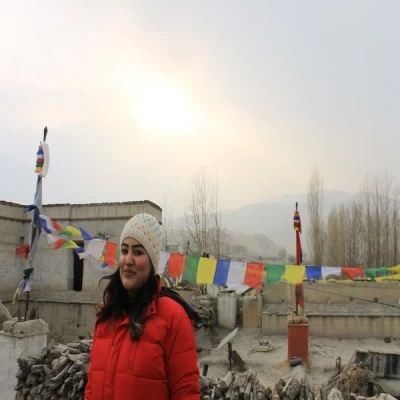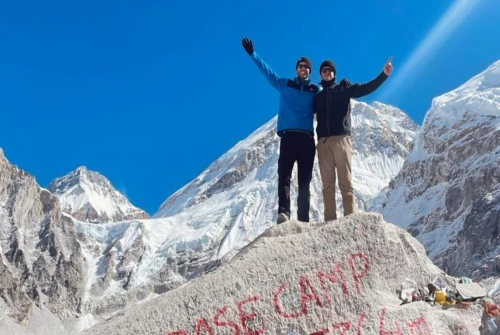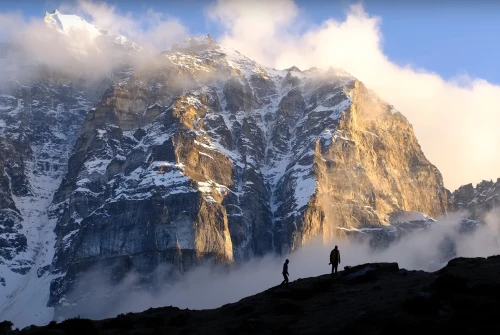The Manaslu Circuit Trek is a remote, demanding, and breathtaking journey that takes you deep into the wild heart of the Himalayas. Circling Mount Manaslu (8,163m), the world’s eighth-highest peak, this trek presents more than just majestic mountain views. It offers a true test of endurance, resilience, and mental strength. Unlike other popular trekking regions in Nepal, the Manaslu region remains wonderfully off the radar, with fewer trekkers, less infrastructure, and an intense natural and cultural immersion.
What makes the difficulty of the Manaslu Circuit Trek so distinct is its blend of challenges: altitude, remoteness, long trekking days, and limited comforts. But for those ready to take it on, the experience is unforgettable. In this in-depth guide, we’ll explore everything you need to know about how hard the trek is, from fitness requirements and acclimatization to food availability, accommodation conditions, and more.
How Difficult is the Manaslu Circuit Trek Compared to Other Treks in Nepal?
The Manaslu Circuit ranks as a moderately to highly difficult trek, especially when compared to classic routes like Annapurna Base Camp or Langtang Valley. Unlike the busier trails with developed infrastructure and rescue access, Manaslu takes you into a far more isolated environment where self-reliance and preparation are key.
This trek requires multi-day walking at high altitude, often over challenging terrain such as narrow ridgelines, suspension bridges, scree-covered slopes, and even icy patches depending on the season. The altitude, especially at Larkya La Pass (5,160m), adds to the intensity. However, what you get in return is something few treks offer: authentic Himalayan wilderness, Tibetan Buddhist culture, and panoramic mountain views with hardly a crowd in sight.
Do You Need to Be Young to Do the Manaslu Circuit Trek?
Absolutely not. Age is not the most important factor when it comes to trekking the Manaslu Circuit; physical preparedness and mindset are. Trekkers in their 50s, 60s, and even 70s have completed this trek successfully, often outperforming younger hikers simply by being patient, consistent, and well-prepared.
Older trekkers tend to pace themselves better, take fewer risks, and listen to their bodies qualities that are vital in high-altitude environments. The real key is training in advance and understanding your physical limits. If you're reasonably healthy, injury-free, and can follow a structured training routine, age should not hold you back from experiencing the Manaslu region’s raw beauty and cultural richness.
What Makes the Manaslu Circuit Trek Challenging?
Altitude and Acclimatization
Altitude is the most consistent difficulty on the Manaslu Circuit. You’ll ascend from 700 meters at Soti Khola to more than 5,000 meters over two weeks. This rapid gain increases the risk of Acute Mountain Sickness (AMS), and symptoms like headaches, fatigue, and nausea can affect anyone, regardless of age or fitness.
Acclimatization days in Samagaun (3,530m) and Samdo (3,875m) are built into the standard itinerary to help your body adjust. Going slow, staying hydrated, and listening to your body are vital strategies for adapting safely. Make sure to inform guides in case of unease; they will help you and give the best advice on what should be done.
Length and Trekking Hours
The trek typically takes 14 to 18 days to complete, including acclimatization and contingency days. Each day involves 6–8 hours of trekking, often through elevation gain, steep climbs, and technical descents. The Larkya La Pass crossing day is particularly exhausting, often stretching to 10 or more hours in high-altitude and freezing conditions.
Rugged and Unpredictable Terrain
Expect trails that challenge your coordination and concentration. From lush river valleys and bamboo forests to glacial moraines and alpine cliffs, the terrain is varied and frequently unstable, especially after the monsoon season. You may need to cross landslide-prone areas, slippery stone steps, and icy passes, especially in spring or winter.
How Physically Fit Do You Need to Be for the Manaslu Circuit Trek?
Completing the Manaslu Circuit Trek requires a solid level of physical fitness. You don’t need to be a marathon runner, but you do need endurance, core strength, and stamina. Trekkers should be capable of walking for 6 to 8 hours a day over rugged, uneven trails that include steep climbs, river crossings, and high passes. The most physically demanding day is the crossing of Larkya La Pass (5,160m), where you may walk for up to 10 hours at high altitude.
Because of the high elevation and limited oxygen, even small efforts can feel exhausting. Good cardiovascular conditioning will help you breathe more efficiently, while leg and core strength will prevent injuries on long descents. Being fit doesn’t just make the trek easier; it also makes it safer and more enjoyable. The more prepared your body is, the better it can handle the altitude and recover day after day.
How Should You Train for the Manaslu Circuit Trek?
A smart training program is essential, regardless of your experience level. Your preparation should start at least 6–8 weeks before your trek and include:
Cardio: Focus on long-duration exercises like hiking, jogging, swimming, or cycling to build stamina.
Strength Training: Include leg-focused workouts like squats and lunges, and don’t forget core exercises like planks and deadlifts.
Hiking with a Pack: Simulate real conditions by hiking with a weighted backpack to get your body used to the load.
Flexibility: Regular stretching or yoga will improve your range of motion and reduce injury risk.
Mental Prep: Read accounts, watch videos, and prepare for moments of fatigue or discomfort, it’s part of the journey.
How Remote Is the Manaslu Circuit, and How Does That Affect the Trek?
The remoteness of the Manaslu Circuit is both its charm and its challenge. Unlike the busy Everest and Annapurna routes, the Manaslu trail winds through isolated mountain villages, suspension bridges, and forests, where you’ll often walk for hours without seeing another group. There are no roads or quick exit points, so once you’re in, you're committed to the trail.
This remoteness means:
- Fewer and more basic teahouses
- Limited access to modern medical facilities
- No mobile network in many sections
- Dependence on porters and guides for supplies and support
If something goes wrong, such as injury or altitude sickness, it can take hours or even days to evacuate. That’s why trekking insurance with helicopter rescue coverage is mandatory, and having a licensed guide and porter is highly recommended, not just for navigation and translation, but for safety.
Is It Difficult to Find Food on the Manaslu Circuit Trek?
While you won't find gourmet dining on the trail, food is available at every teahouse, and meals are hot, hearty, and high in carbs—perfect for trekking. The most common dish is dal bhat (rice, lentils, vegetables), which provides sustained energy. You'll also find noodles, pasta, soups, eggs, chapati, and sometimes even yak cheese and Tibetan bread.
However, the variety of food decreases as you ascend. Higher up, the selection becomes simpler and more repetitive, and items like meat, fresh fruits, and dairy may be unavailable. It’s wise to carry energy bars, nuts, dried fruit, and hydration tablets to supplement meals.
Drinking water is available, but you’ll need to purify it using tablets, filters, or UV pens to avoid stomach issues. And remember—everything you eat has been carried up by porters or mules, so don't expect luxury. Appreciate the simplicity and the effort it takes to serve food in such remote conditions.
How Difficult Is It to Get Accommodation on the Manaslu Circuit?
There are teahouses available in all the key overnight stops, but the quality and availability vary. In lower elevations like Soti Khola, Namrung, or Samagaun, you’ll find comfortable teahouses with proper beds, blankets, and decent food. But as you move closer to Larkya La, accommodation becomes much more basic, sometimes offering shared dorms, outdoor toilets, and no running water.
During the peak trekking seasons (March–May and October–November), teahouses can fill up fast, especially in smaller villages. Trekkers who don’t book in advance may end up sleeping in dining halls or sharing rooms. That’s another reason to trek with a local agency; they pre-arrange your stays, making the journey smoother.
Bringing a lightweight sleeping bag, a towel, and personal hygiene items will make your stay more comfortable. And while Wi-Fi is rare, the views more than make up for it.
What’s the Best Season to Minimize Trek Difficulty?
The best trekking time for the Manaslu Circuit Trek is:
Autumn (September to November)
The most popular and safest time for the Manaslu Circuit. Expect clear skies, cool temperatures, and dry trails. Ideal for crossing the Larkya La Pass.
Spring (March to May)
Warmer temperatures and blooming rhododendrons make this a beautiful time, though snow may still linger at higher altitudes.
Avoid monsoon (June to August), trails become dangerous with landslides and leeches. Winter (December to February) is very cold with snow blocking high passes, making the trek highly challenging and sometimes impassable.
Do You Need Permits for the Manaslu Circuit?
Yes. As the trail passes through a restricted area, multiple permits are mandatory:
- Manaslu Restricted Area Permit (MRAP) – $100 for first 7 days (then $15/day)
- Manaslu Conservation Area Permit (MCAP) – $30
- Annapurna Conservation Area Permit (ACAP) – $30
Also, solo trekking is prohibited. You must travel with a licensed guide and be part of a group of at least two foreign nationals arranged through a Nepali agency. You can also refer to Manaslu Circuit Trek Permits and Costs for detailed information.
Where Does the Remoteness Become a Challenge?
The remoteness of the Manaslu Circuit is a double-edged sword; it offers serenity but demands self-sufficiency. Once you begin, there are no exit roads or hospitals until you reach the Annapurna side. If an emergency arises, it could take hours or days for evacuation. Communication is limited, and services like Wi-Fi or phone signal are unreliable or unavailable.
This isolation means you must be well-prepared with gear, medication, and trusted local support. But it’s also what makes the trek so immersive and spiritually rewarding.
Can You Trek the Manaslu Circuit Solo?
No. The Manaslu region is a restricted area and requires a guide and at least two trekkers. Going solo is not permitted by the government. Besides legality, having a guide adds safety, insight into the culture, help with logistics, and critical support in emergencies.
Is the Manaslu Circuit Trek Worth the Challenge?
Without a question, yes. The Manaslu Circuit Trek combines raw nature, cultural immersion, and physical endurance into one life-changing journey. It's not for the faint-hearted, but for those who take on its challenges, it’s a deeply rewarding experience unmatched by more commercial trails.
With the right mindset, solid preparation, and support from experienced guides, you can conquer Manaslu and come back with a story to tell for a lifetime.
Final Thoughts: Are You Ready for the Manaslu Circuit?
The Manaslu Circuit Trek is a true Himalayan adventure, ideal for those who want an authentic, less-traveled route with dramatic landscapes and cultural immersion. But it’s not an easy walk in the park. It requires solid physical fitness, careful planning, and respect for altitude. The terrain is remote, the facilities are basic, and the trek is long, but the rewards are massive.
From the snow-clad Larkya La Pass to the warm smiles of Nubri villagers, every step offers something profound. Whether you're 25 or 65, if you're healthy, determined, and prepared, the Manaslu Circuit is a trek you’ll never forget.


.webp)

